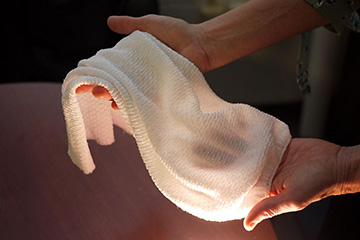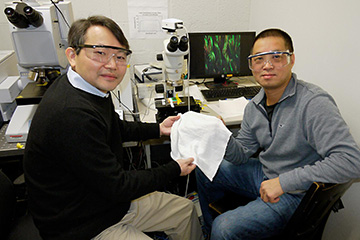
A new fabric automatically changes properties to trap or release heat depending on environmental conditions. [Image: Faye Levine / University of Maryland]
Researchers from the University of Maryland, USA, have designed a fabric that uses infrared (IR)-radiation gating to bidirectionally regulate the wearer’s body temperature—it can cool or warm, depending on the environment (Science, doi: 10.1126/science.aau1217). The high-tech metatextile’s thermoregulation abilities come from a conductive carbon-nanotube coating that shifts the fabric’s emissivity to IR radiation, and polymer fibers that shrink or expand the weave of the fabric in response to temperature or humidity.
Humans retain and lose a lot of their body heat through IR radiation, so the research team believes that clothing made from this fabric could be particularly useful in demanding environments. During tests, the team reports that the metatextile significantly altered IR radiation in response to changes in relative humidity, and switched from heating to cooling mode in less than a minute.
Self-powered thermoregulation
IR radiation accounts for about 40 percent of the body’s heat loss and gain. While fabrics exist that can warm the wearer by trapping IR radiation or cool by reflecting sunlight, the Maryland researchers, led by Led by YuHuang Wang and Ouyang Min, say that their metatextile is the first fabric that can either warm or cool the wearer in response to environmental changes.
The new metatextile is knit from commercially available hydrophilic cellulose and hydrophobic triacetate fibers and coated with conductive carbon nanotubules in a process similar to solution dyeing—a common method for dyeing synthetic fibers.
When the fabric becomes hot or damp, the fibers collapse, opening the weave of the fabric. This creates bigger pores that allow heat radiating from the body to escape. At the same time, the fiber collapse brings neighboring carbon microtubules closer together. Shortening the distance between the nanotubes creates resonant electromagnetic coupling, matching the IR emissivity of the wearer’s skin. This “opening” of the IR-radiation gate results in radiative cooling.
Conversely, when the fabric cools and dries, the fibers expand, closing the weave to trap heat. This increases the distance between the nanotubes, “closing” the IR-radiation gate and reducing IR heat exchange through the fabric.

University of Maryland’s YuHuang Wang (left) and Min Ouyang hold a swatch of their metatextile. [Image: Faye Levine / University of Maryland]
Testing the metatextile
The researchers were able to knit a 0.5-m2 swatch of their metatextile to demonstrate manufacturing scalability. To confirm that the dynamic IR-radiation gating was indeed a result of electromagnetic wave interactions between carbon nanotubes, they performed three-dimensional finite-difference time-domain simulations of the metatextile’s fiber structure. They also captured the shift in fiber spacing in humid and dry conditions in real time using confocal fluorescence microscopy and a fluorescently dyed swatch of their fabric.
To quantify the metatextile’s performance, the Maryland team used a Fourier-transform IR spectrometer attached to a humidity-varying environmental chamber containing a small swatch of the fabric. The team found that the fabric could accomplish a 35-percent relative change in IR transmittance, and could switch from cooling mode to heating mode in less than a minute.
The team reports that there is still much work to be done before the metatextile appears in activewear; however, it believes that the modeling and experimental results are promising for this self-powered, autonomous fabric.
